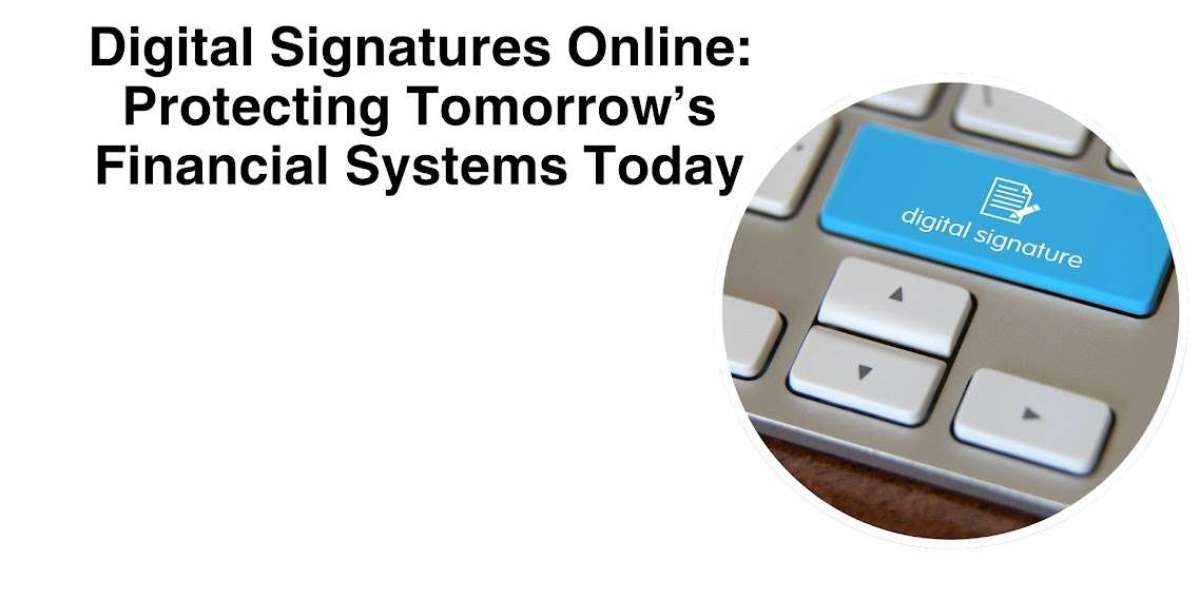The rapid advancement of digital technology has transformed nearly every aspect of our lives, especially in the financial sector. The shift from traditional paper-based processes to online systems has brought about tremendous convenience and efficiency. However, with this shift comes a pressing need for security measures that can ensure the integrity and authenticity of digital transactions. One of the key innovations in securing online financial transactions is the use of digital signatures.
Digital signature online serves as a critical tool in the world of online finance, ensuring that transactions remain secure, verifiable, and tamper-proof. They are revolutionizing the way we conduct financial transactions, making them more secure and efficient, and ultimately fostering trust in the digital economy.
This article explores how digital signatures are securing the future of financial transactions, detailing their role in enhancing security, preventing fraud, ensuring compliance, and boosting overall trust in digital financial systems.
What is a Digital Signature?
Before diving into the impact of digital signatures in the financial sector, it’s important to understand what a digital signature is and how it works.
A digital signature is a cryptographic technique used to validate the authenticity and integrity of digital messages, documents, and transactions. Unlike traditional handwritten signatures, which can be easily forged, digital signatures provide a higher level of security through encryption and public key infrastructure (PKI). They use a unique pair of cryptographic keys—a private key and a public key—to secure data and verify the identity of the parties involved in a transaction.
In the context of financial transactions, digital signatures are used to ensure that the person initiating the transaction is who they claim to be, that the transaction has not been altered, and that the sender’s consent to the transaction is genuine.
The Role of Digital Signatures in Online Financial Transactions
Ensuring the Authenticity of Transactions
In the world of finance, ensuring the authenticity of transactions is paramount. Digital signatures make it possible for financial institutions and businesses to verify the identity of the parties involved in an online transaction. By using PKI-based digital certificates, financial institutions can verify that a transaction has been initiated by a legitimate user and not an impostor.
The private key used by the sender to sign a document ensures that the transaction is uniquely linked to the sender, while the public key allows the recipient to verify the sender's identity. This ensures that fraudulent transactions, such as those initiated by hackers or identity thieves, are virtually impossible to carry out.
Securing Data and Preventing Tampering
One of the primary security concerns in online financial transactions is the risk of data tampering. A malicious actor could intercept and alter transaction data during its transmission, potentially causing significant financial loss.
Digital signatures address this issue by encrypting the data in a way that any alteration would be immediately detectable. When a financial document or transaction is signed digitally, the digital signature not only authenticates the signer’s identity but also ensures the integrity of the data itself. If even a single character in the document is altered after it has been signed, the digital signature becomes invalid, signaling potential fraud or tampering.
Preventing Fraud and Identity Theft
Financial fraud and identity theft are growing concerns in the digital age. Cybercriminals often attempt to gain access to personal and financial information by impersonating legitimate users. Digital signatures provide a robust defense against these types of fraud by making it nearly impossible to forge a signature without access to the private key, which only the legitimate user possesses.
Additionally, the use of two-factor authentication (2FA) in conjunction with digital signatures provides an added layer of security. Even if a hacker gains access to a user’s credentials, they would still need the physical device or token used to authenticate the signature, making it far more difficult for fraudsters to succeed.
Facilitating Secure E-Commerce and Online Banking
In the realm of e-commerce and online banking, digital signatures have become a cornerstone of secure transactions. Whether it's authorizing payments, signing loan agreements, or transferring funds, digital signatures ensure that each action is secure and that the involved parties are legitimate.
For example, when a customer makes an online payment or submits an application for a financial product, they can digitally sign the transaction to confirm their consent and authenticate their identity. This reduces the risk of chargebacks, disputes, and unauthorized transactions, ultimately providing a secure environment for online banking and e-commerce.
Enabling Smart Contracts in Financial Services
A rapidly growing area in the financial sector is the use of smart contracts, which are self-executing contracts with the terms of the agreement directly written into lines of code. These contracts are often used in blockchain-based financial applications and can be made more secure through the use of digital signatures.
In the context of smart contracts, digital signatures are used to authenticate the parties involved and ensure that the terms of the contract are executed automatically and securely. The digital signature ensures that the contract is legitimate, and any changes made to the contract would be immediately visible, ensuring that all parties are in agreement before the contract is executed.
How Digital Signatures Contribute to Financial Compliance
Compliance with legal and regulatory frameworks is a critical aspect of financial transactions, particularly in the digital space. Financial institutions must adhere to strict regulatory requirements to ensure the safety and security of transactions. Digital signatures help meet these compliance standards in several ways:
Meeting Legal Requirements for Digital Transactions
Many jurisdictions around the world, including the European Union and India, have specific laws governing the use of digital signatures in financial transactions. For example, the eIDAS Regulation in the EU and the Information Technology Act of 2000 in India provide a legal framework for the use of digital signatures in business transactions, including financial services.
By using digital signatures, financial institutions and businesses can ensure that their transactions comply with these regulations, making them legally binding. This also provides a level of legal protection for both the sender and recipient in case of a dispute.
Ensuring Audit Trails and Transparency
Digital signatures also play a crucial role in ensuring that financial transactions are transparent and traceable. In financial services, maintaining an audit trail is essential for monitoring the flow of money, ensuring compliance, and detecting fraud. Digital signatures help create a clear and immutable record of who signed a document, when it was signed, and what changes were made. This audit trail can be critical for financial institutions when conducting internal audits or responding to regulatory inquiries.
Supporting Anti-Money Laundering (AML) and Know Your Customer (KYC) Requirements
Digital signatures also play a key role in supporting anti-money laundering (AML) and know your customer (KYC) initiatives. In the financial sector, it is essential to verify the identity of customers and ensure that they are not involved in illicit activities. Digital signatures can be used in conjunction with KYC procedures to verify the identity of customers, secure their data, and ensure that the financial institution is meeting regulatory requirements.
The Future of Digital Signatures in the Financial Sector
Blockchain and Cryptocurrencies
One of the most significant technological advancements that is shaping the future of financial transactions is blockchain technology. Digital signatures are integral to blockchain, as they help secure transactions on the decentralized ledger. In the world of cryptocurrencies, for example, digital signatures are used to verify the identity of the parties involved in a transaction and ensure the integrity of the blockchain.
As blockchain technology continues to evolve, digital signatures will remain a cornerstone of secure financial transactions. They will enable the continued growth of decentralized finance (DeFi) and blockchain-based financial products, further reducing the need for intermediaries and increasing the efficiency of financial services.
Artificial Intelligence and Automation
The integration of artificial intelligence (AI) and machine learning (ML) into financial services is another trend that will shape the future of financial transactions. Digital signatures will be used alongside AI-driven technologies to automate and streamline processes such as fraud detection, risk assessment, and contract execution.
AI-powered systems will be able to analyze vast amounts of data in real-time to identify potential fraud or anomalies, and digital signatures will provide a secure way to authenticate and verify the actions taken by these systems. This combination of digital signatures and AI will help make financial transactions more secure, efficient, and scalable.
Global Interoperability and Cross-Border Transactions
As the global economy becomes increasingly interconnected, the ability to conduct cross-border financial transactions seamlessly will become even more important. Digital signatures will play a crucial role in enabling secure international transactions, ensuring that they are legally recognized and authenticated across different jurisdictions.
With advancements in digital signature standards and regulations, it will become easier for financial institutions and businesses to facilitate cross-border transactions without worrying about security or compliance issues.
Steps to apply for Digital Signature Online
Step 1: Visit Our Website
Go to our website to start the process.
Step 2: Fill in Your Details
User Type: Choose if you are an individual or an organization.
Certificate Type: Pick if you need it just for signing documents or for both signing and encryption.
Validity: Choose how long you want the certificate to last.
Personal Info: Enter your name, phone number, email, and address.
Agree to Terms: Check the box to agree to the terms.
Submit: Click the submit button.
Step 3: Choose Token Option
Already Have a Token?: If you have a USB token, choose "No." If you need a new one, choose "Yes."
Step 4: Make Payment
Payment: Enter your payment details and choose how you want to pay (net banking, credit card, debit card, or UPI).
Step 5: Complete the Process
Review: Make sure all your information is correct.
Submit: Click submit and wait for a confirmation email.
Step 6: Get Your Digital Signature
You’ll receive your digital signature on a USB token drive after processing.
Also read:- What is emudhra?
Conclusion
Digital signatures are at the forefront of securing online financial transactions, providing a powerful solution to the growing challenges of fraud, data tampering, and identity theft. They ensure that transactions are authentic, secure, and verifiable, offering a level of trust that is crucial for the digital economy. As the financial sector continues to evolve, digital signatures will remain a vital tool in securing the future of financial transactions, enabling the growth of innovative technologies such as blockchain and AI, and fostering a more secure, transparent, and efficient global financial system.







